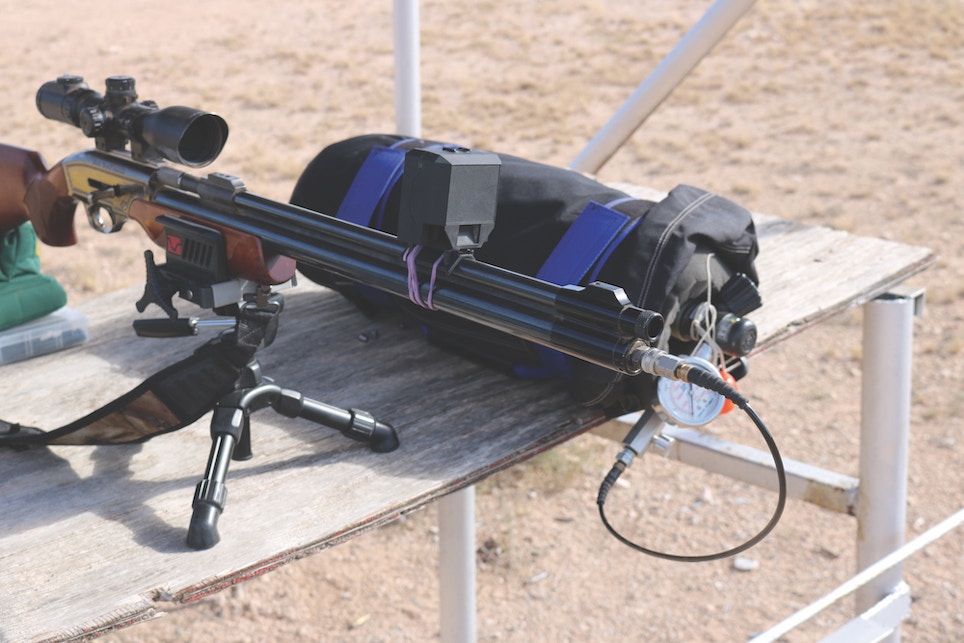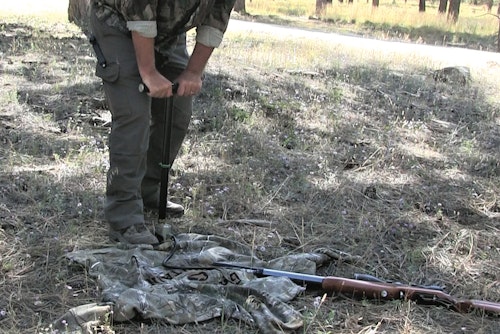
This big-bore rifle needs to be refilled every four shots, and a CF tank is the easiest and fastest means of charging it.
I am often asked how I fill my pre-charged pneumatic air rifles? Because I shoot so much, with so many rifles and in so many places, my answer is that I need a range of options. I started out with a hand pump but eventually moved on to a high-pressure tank until finally acquiring a compressor to fill the tanks myself. Let’s look at the different approaches to feeding a PCP, and I’ll explain some of the pros and cons of each.
Not all guns are created equal when it comes to the volume of air stored, or the pressure required to fill them. Some guns use a low-volume air reservoir while others implement high-volume bottles, usually taking up a position of the fore-stock or the buttstock of the rifle. The reason for this is quite simple; a larger volume of air under higher pressure means the rifle’s shot count can be increased. This is especially true for more powerful and larger-caliber guns, where each shot expends more air than lower-power, smaller-chamber guns. It is not unusual for a typical .22-caliber rifle to get more than 50 shots per fill, while a typical .457 will usually get around five shots per fill.
When designing a rifle, gunmakers are looking for a balance between caliber, energy produced, number of shots, consistency, dimensions of air reservoir and operating pressures. This balance is not cut and dried, it depends on several factors, many of those related to how the rifle will be used. For example, a target or plinking rifle might not require high energy levels, in fact the user requirement might be that the gun operates at lower energy levels. In this case, the user would rather have a gun that is quiet, offers low penetration, has a high shot count and ranks accuracy over every other consideration. Such a rifle might be a .177-caliber, shooting at 650 fps and yielding 75 shots from a 3,000-psi fill.
A small-game hunter, on the other hand, might want a .25-caliber gun generating 60 fpe for 18 shots from a 4,500-psi fill. The designer would take this into consideration and give weight to shot count over energy output for the former and energy over the shot count for the latter.
Another factor is if a gun is regulated or not. In basic terms, a regulator is a device that sits between the air reservoir and the firing valve of the gun. The regulator allows air to flow from the reservoir into the regulator (firing) chamber until a predetermined pressure is reached, at which time the inflow valve closes. It is this volume of air that is released when the trigger is pulled, and the firing valve opens. The result is that every shot uses the same volume and pressure of air so there is greater consistency (and accuracy), less wasted air, and the gun can be tuned for a specific application or projectile. This is the airgunner’s equivalent to handloading.

Filling Strategies
We’ve touched on some of the factors around air use, and size of the reservoir, fill pressure, caliber and regulated or unregulated action all come into play. Now it’s time to look at the different filling strategies, and handpumps are the appropriate place to start.
Handpump … A handpump for airguns looks like a bicycle tire pump on steroids. They are bigger, made of much heavier metal parts and take a lot of effort to pump. Consider that the bicycle tire you filled as a kid required 20 to 30 psi, while the fill pressure of the standard air rifle is 3,000 psi. It takes a lot more effort to compress the air for an airgun. I am 6 feet, 1 inch tall and weigh 200 pounds and I need to put all my weight into pumping the gun, especially as the fill pressure creeps up.
To use a handpump, the first step is to attach it to the gun, which requires a compatible connection between the pump hose and the rifle, typically using either a quick fill connector or a proprietary fill probe. The pump will have a bleed valve and a pressure gauge. Close the bleed valve and start pumping. Depending on the residual pressure in the gun and the pressure you need to fill to, it might require 75 to 150 pumps, so eat your Wheaties and get started.
The advantages of handpumps are a relatively low price tag, reliability, they are fully self-contained, easy to travel with and you’ll get a bit of exercise. On the downside, they take a lot of effort, are the slowest means of filling your gun and you’ll get a bit too much exercise if you are out for a day on the range.
The fill pressure is monitored using the gauge on the gun or the gauge on the pump. I typically go by the gun’s gauge when I have the option. Once the fill pressure is reached, the bleed valve is opened, and the gun is disconnected. You should always bleed the line before disconnecting because not doing so will cause a loud crack and scare everyone half to death, not to mention that it could result in injury.
High-pressure tanks … The natural progression is to move rather quickly to using either SCUBA or carbon-fiber, high-pressure tanks. These tanks are filled from an external source and store a large volume of air, usually enough to fill your guns several times before they need to be refilled. SCUBA tanks typically can be filled to a maximum of 3,000 psi, and most carbon-fiber tanks can go up to 4,500 or even 5,000 psi. There are some tradeoffs between the two. SCUBA tanks tend to be much heavier, hold less air and the previously mentioned pressure limitation.
If you have a gun that fills to 4,300 psi, the SCUBA tank will be incapable of filling it to capacity. Carbon-fiber tanks are much lighter, hold more air at a higher pressure, but are much more expensive. Regardless of which option you select, there is something else to consider; you’ll need to find a dive shop or paintball shop with a compressor to fill your tanks. And in the case of carbon-fiber tanks, they must be able to fill them to a very high pressure. The cost of the tank can be as much as the gun, and you’ll have to pay a few bucks each time it is refilled.
Buy a compressor … The ultimate quest for air is getting your own compressor, but until recently this was expensive — something in the $3K to $5K range was not unusual. However, these prices have come down and there are several good compressors available in the $1K to $2K range. The nice thing about having your own compressor is that high-capacity airguns can be filled directly, or you can choose to fill a carbon-fiber tank. You must shoot a lot to make this option economically viable, but it’s a great justification to get more airguns!
There is an alternative to buying a full feature industrial compressor, and several companies are now making small units that can run on AC or DC power, designed to fill an individual airgun as opposed to a high-volume CF (external) tank. These typically cost in the $400 to $800 range and provide a virtually endless supply of air. On the downside, it takes longer to fill your gun than from a tank, though still much faster (and easier) than a handpump.

Weighing Your Options
I have all these options in my gear room. But to be honest, I don’t use the handpump very often anymore, except sometimes when traveling by air for a hunt because air tanks are difficult to travel with. The tanks must be empty and disassembled for inspection before they can be checked on a flight. This means when you get to your destination, you do so with an empty bottle. If I cannot arrange to have full air tanks waiting on the other end, I’ll pack either a Hill pump or a Hatsan pump to charge my guns.
I use a full-size Omega compressor purchased from Airguns of Arizona to keep several CF tanks charged and ready to go. I also have the Hatsan Spark, Air Venturi Nomad and Air Marksman portable compressors, that all get regular use. We’re off on a hunt in Texas next week, traveling by car, so there isn’t a significant limit on gear. The intention, besides hunting, is to do a lot of target shooting and plinking with several new guns. In preparation, my heavy-duty Omega compressor was used to fill two 74 cubic feet carbon-fiber tanks and a couple small buddy bottles (in case I want to pack extra air on my hunts). I will also take one of the portable DC compressors to charge guns when time is not an issue.
With this gear I should be good for a week on the ranch and a whole bunch of shooting. If I do start to run low on the tanks, I will use the tanks to charge up as high as their residual pressure will allow, then top off with the portable compressor.
The take-away is that there are several options for filling your guns, each with pros and cons. Think about how you use your guns, under what conditions will you normally need to refill them and pick the method that works best for you. Do remember, though, that if you go down the PCP path, you will need a means of keeping the gun charged.





